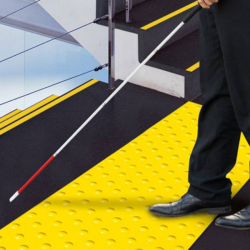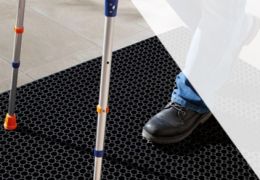Choosing the right podotactile tiles
We see them everywhere, on the edges of crosswalks, on the first and last steps of staircases, and on streetcar and train platforms. Podotactile tiles are equipment that ensures the safety and accessibility of passers-by, and more specifically the visually impaired. To install this type of flooring, it's important to know its specific features and the regulations in force. NeoSol, as a specialist in these systems, provides you with the information you need to know.
What is a podotactile tile?
Also known as a "bande d'éveil de vigilance", a podotactile tile is a safety device used mainly to signal danger. It can be used to warn of an obstacle, an exit zone, the edge of a platform, staircase or sidewalk, or a crosswalk. Podotactile tiles are very useful for the visually impaired or blind, as they enable them to detect by the touch of their feet that they are about to cross an obstacle.
The podotactile tile is made up of raised pimples that are easily detectable by touch. There are several types of paving slabs, depending on their criteria. That's why, before choosing the one best suited to your situation, it's essential to take into account the legal standards governing the installation of this device.
What do the regulations say about podotactile tiles?
It's a legal obligation to make public buildings and facilities accessible to all.AFNOR, which defines and dictates the standards to be complied with, provides a framework for the installation of pedomark tiles with 2 standards:
- NF PR98-351
- NF P98-351
The French standard NF PR98-351 specifies that paving slabs must be installed in very specific places, such as railroad platforms or the top of a flight of stairs.
As for the standard, NF P98-351 highlights the characteristics of a paving slab. Depending on the location, the width of the slab must be between 40 and 58.75 cm. The slab must be non-slip, stable and resistant to moisture and wear. It must also be positioned 50 cm from the danger zone.
3 criteria for the right choice
In addition to taking into account the standards for podotactile floor tiles, there are 3 other criteria to consider:
1. The number of studs: Each tile has a number of raised studs. The standard states that each tile must have 8 studs in the depth direction.
2. Arrangement of studs: each stud should be 75 mm apart and staggered.
3. Material: Make sure you choose the right material for the slab, as some materials are sensitive to humidity and rust more easily.
Installing paving slabs: instructions for use!
Whether indoors or outdoors, podotactile tiles are easy to install. They feature a canvas-printed inner face for easy gluing. They are designed to adapt to all types of flooring. However, there are a few rules to be observed when installing it.
Firstly, it's important to respect the 50 cm distance between the podotactile strip and the obstacle. This distance will give the person time to stop and prepare to cross the obstacle safely and calmly.
Next, the strip must be parallel to the kerb: crosswalk, platform, staircase, etc.
Also, as the standard indicates, the strip must be 58.75 cm wide. This dimension is regulated to enable the individual passing over the strip to be aware of the signal. There is, however, an exception for public transport platforms, where the required width is 40 cm.
Finally, if you have several tiles, make sure they are arranged asymmetrically, so that there is no gap between the studs. The floor must not be the same color as the tile, so it's essential that it be contrasting. Neosol also offers other accessibility and safety equipment for people with reduced mobility, as well as a wide range of professional mats for all sectors of activity.
NEED ADVICE?
Contact Solène
![Fire classification, UPEC and ISO 10874 standards Fire classification, UPEC and ISO 10874 standards]() Fire classification, UPEC and ISO 10874 standardsFire rating and quality standards should be one of the main criteria to consider before buying professional flooring. Find out why with NEOSOL.Read More
Fire classification, UPEC and ISO 10874 standardsFire rating and quality standards should be one of the main criteria to consider before buying professional flooring. Find out why with NEOSOL.Read More![Static electricity risks and solutions Static electricity risks and solutions]() Static electricity risks and solutionsHow dangerous is static electricity for employees? How do industries reduce the risks associated with electrostatic discharge?Read More
Static electricity risks and solutionsHow dangerous is static electricity for employees? How do industries reduce the risks associated with electrostatic discharge?Read More![Professional mats: how to care for them? Professional mats: how to care for them?]() Professional mats: how to care for them?Professional mat maintenance is essential to maintain the longevity of your mat and the safety of passers-by. NEOSOL, the flooring expert, reveals its different maintenance methods.Read More
Professional mats: how to care for them?Professional mat maintenance is essential to maintain the longevity of your mat and the safety of passers-by. NEOSOL, the flooring expert, reveals its different maintenance methods.Read More![Accessibility and ERP: how do I know if I'm in compliance? Accessibility and ERP: how do I know if I'm in compliance?]() Accessibility and ERP: how do I know if I'm in compliance?Accessibility must be a priority for every ERP. But you still need to know if you're in compliance. To help you, NeoSol, the professional flooring specialist, tells you more.Read More
Accessibility and ERP: how do I know if I'm in compliance?Accessibility must be a priority for every ERP. But you still need to know if you're in compliance. To help you, NeoSol, the professional flooring specialist, tells you more.Read More















Leave a comment